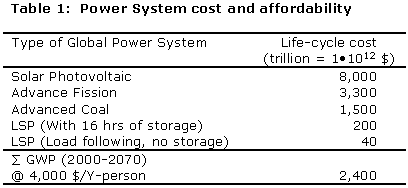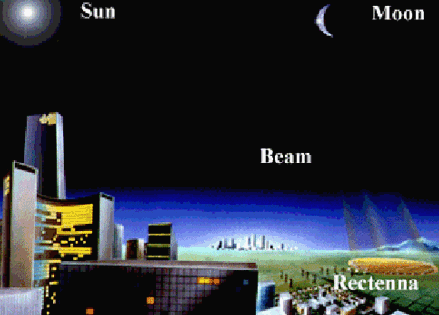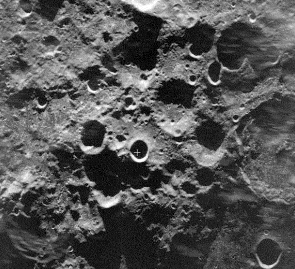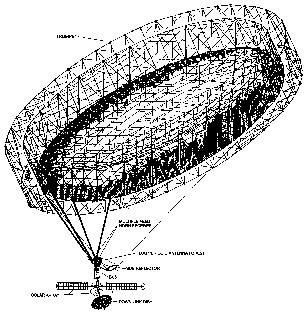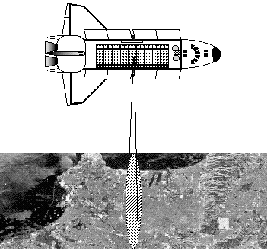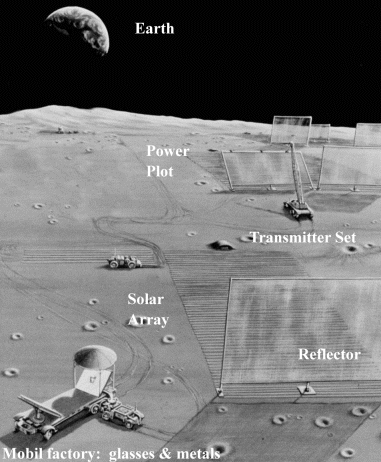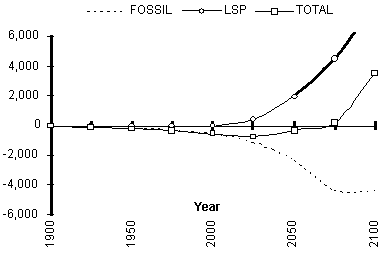
Dr. David R. Criswell
Approximately6 kWt/person or, eventually, 2 kWe/person can enable energy prosperity. Note that "t" refers to thermal energy and "e" to electric energy. For a population of 10 billion people, anticipated by 2050, this implies 60,000 GWt or 20,000 GWe. For purposes of discussion, assume that power usage continues to be high to 2070. From 2000 to 2070 the world would consume approximately 3,000,000 GWt-Y or 1,000,000 GWe-Y of energy [1, 2, 3, 4]. It is highly unlikely that conventional fossil, nuclear, and terrestrial renewable power systems can provide the power needed by 2050 and the total energy consumed by 2070. They are restricted by limited supplies of fuels, pollution and wastes, irregular supplies of renewable energy, costs of creating and operating the global systems, and other factors.
It is technically and economically feasible to provide at least 100,000 GWe of solar electric energy from facilities on the Moon. The Lunar Solar Power (LSP) System can supply to Earth power that is independent of the biosphere and does not introduce CO2, ash, or other material wastes into the biosphere. Inexhaustible new net electrical energy provided by the LSP System enables the creation of new net material wealth on Earth that is decoupled from the biosphere. Given adequate clean electric power, humanity's material needs can be acquired from common resources and recycled without the use of depletable fuels [4, 5]. LSP power increases the ability of tomorrow's generations to meet tomorrow's needs, and enables humanity to move beyond simply attempting to sustain itself within the biosphere to nurturing the biosphere.
Fig. 1 illustrates the essential features of the LSP System: Sun, Moon, microwave power beam from a power base on the Moon, and a microwave receiver or rectenna on Earth. The LSP System uses bases on opposing limbs of the Moon. Each base transmits multiple microwave power beams directly to Earth rectennas when the rectennas can view the Moon. Each base is augmented by fields of photoconverters just across the limb of the Moon. Thus, one of the two bases in the pair can beam power toward Earth over the entire. cycle of the lunar day and night. This version of LSP supplies extra energy to a rectenna on Earth while the rectenna can view the Moon. The extra energy is stored and then released when the Moon is not in view.
The LSP System is an unconventional approach to supplying commercial power to Earth. However, the key operational technologies of the LSP have been demonstrated at a high technology readiness level (TRL = 7). TRL = 7 denotes technology demonstrated at an appropriate scale in the appropriate environment [6].
Power beams are considered esoteric and a technology of the distant future. However, Earth-to-Moon power beams of near-commercial intensity are an operational reality. Fig. 2 is picture of the South Pole of the Moon that was taken by the Arecibo radar in Puerto Rico. The Arecibo beam passes through the ionosphere with an intensity the order of 20 - 25 W/m2. The LSP System is designed to provide power beams at Earth with intensities of less than 20% of noon-time sunlight (= 230 W/m2). Lower intensity beams are economically reasonable. The intensity of microwaves scattered from the beam will be orders of magnitude less than allowed for continuous exposure of the general population.
Load-following electrical power, without expensive storage, is highly desirable. Earth orbiting satellites can redirect beams to rectennas that cannot view the Moon and thus enable load-following power to rectennas located anywhere on Earth. Rectennas on Earth and the lunar transmitters can be sized to permit the use of Earth orbiting redirectors that are 200 m to 1,000 m in diameter. Redirected satellites can be reflectors or retransmitters. The technology is much more mature than realized by the technical community at large.
Fig. 3 is an artist's concept of the new Trumpet satellite that employs a 100 m diameter reflector antenna. Trumpet is now in geosynchronous orbit. It is operated by the U.S. National Reconnaissance Office [7]. This reflector, only a few tons in mass, has a diameter within a factor of 1 to 3 of that necessary to redirect a power beam to a 1 km diameter or larger rectenna on Earth. Trumpet is reportedly similar in design to antennas planned for the Hughes commercial HS 601 AMPT satellites. Power beams and redirector satellites can minimize the need for long-distance power transmission lines and their associated systems.
Alternatively, a power beam from the Moon can be received by a receiver satellite. The relay satellite then retransmits new beams to several rectennas on Earth. The transmission of beams, with commercial level intensity in low Earth orbit, has been demonstrated by unmanned and manned spacecraft. Fig. 4 illustrates the NASA Shuttle with a phased array making a synthetic aperture radar picture of the Earth. Near the Shuttle the beam has an intensity the order of 150 W/m2. This is well within the range for commercial transmission of power [6, 8].
Approximately once a year the Earth will eclipse all the lunar power bases for up to 3 hours. This predictable outage can be accommodated by power storage of defined capacity or reserve generators on Earth. Alternatively, a fleet of solar mirrors in orbit about the Moon can reflect solar power to selected bases during eclipses and during sunrise and sunset. These solar reflectors, actually types of solar sails, will be less expensive to build and operate than the high precision reflectors such as in Fig. 3 [6, 7].
The lunar portion of an LSP System prototype Power Base is depicted in Fig. 5. A Power Base is a fully segmented, multi-beam, phased array radar powered by solar energy. This Power Base consists of tens to hundreds of thousands of independent power plots such as depicted in the middle to lower right portion of Fig. 5. Each power plot emits multiple sub-beams. Sets of correlated
sub-beams from all the plots are phased electronically to produce one power beam. A given base can project tens to hundreds of independent power beams.
A power plot consists of four elements. There are arrays of solar converters, shown here as north-south aligned rows of photovoltaics. Solar electric power is collected by a buried network of wires and delivered to the microwave transmitters. Power plots can utilize many different types of solar converters and many different types of electric-to-microwave converters. In this example the microwave transmitters are buried under the mound of lunar soil at the Earthward end of the power plot. Each transmitter illuminates the microwave reflector located at the anti-Earthward end of its power plot. The reflectors overlap, when viewed from Earth, to form a filled lens that can direct very narrow and well defined power beams toward Earth. The Earth is fixed in the sky above the Power Base.
To achieve low unit cost of energy, the lunar portions of the LSP System are made primarily of lunar-derived components [2, 3, 9]. Factories, fixed and mobile, are transported from the Earth to the Moon. High output greatly reduces the impact of high transportation costs from the Earth to the Moon. On the Moon the factories produce 100s to 1,000s of times their own mass in LSP components. Construction and operation of the rectennas on Earth constitute greater than 90% of the engineering costs. Upfront costs can be reduced by using lunar materials to make significant fractions of the machines of production and support facilities. Most aspects of manufacturing and operations on the Moon can be controlled by personnel in virtual work places on Earth [9, 10].
An LSP demonstration Power Base, scaled to deliver the order of 10 to 100 GWe, can cost as little as 20 billion dollars over 10 years [2, 9, 11]. This assumes the establishment of a permanent base on the Moon, by one or more national governments, that is devoted to the industrial utilization of lunar resources for manufacturing and logistics. Such a base is the next logical step for the world space programs after completion of the International Space Station.
LSP is practical with 1980s technology and a low overall efficiency of conversion of sunlight to Earth power of ~0.15%. Higher system efficiencies, = 35%, are possible by 2020, and greater production efficiencies sharply reduce the scale of production processes and up-front costs. An LSP System with 35% overall efficiency will occupy only 0.15% of the lunar surface and supply 20,000 GWe to Earth.
There are no "magic" resources or technologies in Fig. 1 or Fig. 5. Any handful of lunar dust and rocks contains at least 20% silicon, 40% oxygen, and 10% metals (iron, aluminum, etc.). Lunar dust can be used directly as thermal, electrical, and radiation shields, converted into glass, fiberglass, and ceramics, and processed chemically into its elements. Solar cells, electric
wiring, some micro-circuitry components, and the reflector screens can be made out of lunar materials. Soil handling and glass production are the primary industrial operations. Selected microcircuitry can be supplied from Earth.
Unlike Earth, the Moon is the ideal environment for large-area solar converters. The solar flux to the lunar surface is predicable and dependable. There is no air or water to degrade large-area thin film devices. The Moon is extremely quiet mechanically. It is devoid of weather, significant seismic activity, and biological processes that degrade terrestrial equipment. Solar collectors can be made that are unaffected by decades of exposure to solar cosmic rays and the solar wind. Sensitive circuitry and wiring can be buried under a few- to tens- of centimeters of lunar soil and completely protected against solar radiation, temperature extremes, and micrometeorites.
The United States has sponsored over 500 million dollars of research on the lunar samples and geophysical data since the first lunar landing in 1969. This knowledge is more than adequate to begin designing and demonstrating on Earth the key lunar components and production processes. Lunar exploration is continuing. The DoD Clementine probe and the new NASA Lunar Prospector (http://lunar.arc.nasa.gov) will extend the Apollo-era surveys to the entire Moon.
The Power Bases direct microwave power beams to rectennas on Earth as shown in Fig. 1. The intensity of each beam can be controlled to provide load following power. The beams pass through clouds, rain, and dust. There is no need for long-distance power transmission lines or indeterminately large systems to store power.
Power beams are assumed to have an intensity of about 20% that of sunlight just above the rectenna (~ 230 W/m2). A few hundred meters from the edge of the rectenna the intensity will be 1% or less of the central intensity. Farther from the rectenna the stray power of a 20,000 GWe system will drop in intensity to that of the light from a full moon. LSP can be competitive with the conventional systems even if the beam is operated at intensities below those allowed for continuous exposure of the general population (10 W/m2 at 1.5 GHz to 100 W/m2 at 15 GHz). The energy received by the rectenna can be fully offset by reflecting back to space, from the area of the rectenna or elsewhere, an equal amount of low-quality solar energy. LSP energy can be environmentally neutral.
Rectennas are the major cost element of the LSP System. Rectennas will occupy as little as 5% of the land-area per unit of received energy as now devoted to the production and distribution of electricity. A rectenna can begin outputting commercial power after it reaches 0.5 km in diameter. Additional construction is paid for out of current revenue. A rectenna of one-square-kilometer area with an average output of 180 MWe produces every year the electric energy equivalent to burning 3.3 million barrels of oil or 650,000 tons of coal in a fossil-fueled electric plant.
Rectennas can be placed virtually anywhere on Earth. It is reasonable to situate them over open land that is not used. It also appears reasonable to place them over agricultural land and industrially zoned property and facilities. They would provide additional revenue the order of 4 $/m2 -Y for power sold at 0.03 $/kWe-h. Rectennas can be placed in countries or regions that do not have indigenous energy resources. Rectennas enable non-polluting solar electric power to efficiently support recycling, use of common mineral resources, and petrochemical processing of hydrocarbons into more valuable process chemicals and products. Rectennas provide both developed and developing countries equal access to electric power for economic development and the enhancement and preservation of the local environment.
Table 1 compares estimated life-cycle costs of five power systems scaled to provide 1,000,000 GWe-Y of energy. The costs are given in trillions (1 T = 1·1012) of U.S. dollars. The estimates are based on studies of systems utilizing 1990s levels of technology [12, 13, 14]. The major cost categories are capital, labor, fuel, and waste handling and mitigation. Thirty percent of the costs of the coal and fission systems are for regional power distribution systems. The terrestrial solar photovoltaic system costs are scaled from studies of globally distributed photovoltaics linked by a global electrical transmission system. However, no power storage is included [15]. Both LSP Systems, power storage on Earth or load-following, offers enormous savings in the cost of production and distribution of electric power. The savings are the order of 1,000 trillion dollars over coal to the order of 8,000 trillion dollars for terrestrial solar photovoltaic.
Cost estimates for the LSP energy are derived from systems level analyses conducted by General Dynamics on the cost of building space solar power satellites (SSPS) from lunar materials [11, 16, 17]. For similar levels of manufacturing and operating technologies the LSP approach is approximately 50 times more cost effective than making SSPS from lunar materials or deploying SSPS from Earth. Lunar and space operations are a small fraction of the LSP System life-cycle cost. For the load-following LSP System the construction and operation of rectennas on Earth represents over 90% of the expenditures. For the LSP that uses power storage on Earth (deep pumped hydro is assumed). The terrestrial expenditures account for over 95% of total costs [18].
The 70 year life-cycle costs of power for an energy-prosperous world are so enormous that it is difficult to understand their scale and significance. One method is to calculate the simple sum of gross world product (GWP) over that same period. Assume that GWP/person is 4,000 $/person-Y over that period. The sum is 2,400 trillion dollars. Alternatively, present economic growth of approximately 2%/Y-person sums to only 3,700 trillion dollars. Such "poor" worlds simply cannot afford to build and operate the coal, fission, and terrestrial photovoltaic systems. Approximately 10% of GWP is now expended on the production and consumption of commercial energy. This corresponds to 240 to 370 trillion dollars between 2000 and 2070. These sums are much smaller than the costs of conventional systems but larger than projected for the LSP System. A poor world must remain energy poor if it uses only conventional
power systems. However, the less costly LSP System electricity can both save money and accelerate the generation of wealth.
Between 1960 and 1986, the total electric energy Ee (Y) used every year, measured in T kWe-h, was an excellent index of the annual GWP in trillions of dollars (T$e(Y)) in a given year "Y" [19, 12]. Equation 1 includes the annual increase in productivity of energy Eff(Y) of approximately 1%/Y. The cost of 1,000 TWe-Y of energy delivered between 2000 and 2070 is taken to be 200 T$.
T$e (Y) = 4.3 T$ + [1.2 T$/TkWe-h]· Ee(Y) · Eff(Y) - 200T$/(70 Y) Equation (1)
Applying Equation (1) to the production of 1,000,000 GWe-Y of energy by 2070 predicts an integral net GWP ~ 14,700 T$ by 2070 or 12,300 T$ more than the 2,400 T$ predicted for a "poor" world. Equation 1 also implies an average annual income in 2070 of 36,000 $ per person. This is approximately 10 times present per capita world income.
Enormous attention is directed to discovering and promoting "sustainable" sources of energy and seeking more efficient means of utilizing conventional commercial and renewable energy. However, there are clear limits to the conventional options. Over 4 billion of Earth's nearly 6 billion people are poor in both wealth and energy. Their existence depends primarily on new net energy taken from the biosphere. This energy is harvested as wood, grass, grain, live stock from the land, fish from the seas, and in many other direct and indirect products. The biosphere incorporates each year approximately 100,000 GWt-Y of solar energy in the form of new net plant mass (algae, trees, grass, etc.). It is estimated that humanity now directly extracts ~ 5% of that new energy and disturbs a much greater fraction of the natural cycles of power through the biosphere. People divert almost 50% of the new solar photosynthetic energy from its natural cycles through the biosphere [21. 22]. Humankind now collects and uses approximately 50% of all the rain water that falls on accessible regions of the continents. Given the continuing growth of human population, most of the fresh water used by humans will be obtained through desalination.
Human energy needs can be accommodated by approximately 6 kWt/person or in the next century by approximately 2 kWe/person [4, 23, 24, 25]. For a population of 10 billion people this corresponds to a minimum of 2,000,000 GWe-Y, or 2,000 TWe-Y, of electric energy per century. Much more energy might be desirable.
It is widely recognized that the lack of affordable and environmentally benign commercial energy limits the wealth available to the majority of the human population [20]. However, there is almost no discussion of how to provide the enormous quantities of quality commercial energy needed for an "energy-rich" world population. The dashed curve of Fig. 6 depicts the cumulative depletion of terrestrial fossil thermal energy by a prosperous human population in tera-Watt-Y (= 1,000 GW-Y) of thermal energy. There is approximately 4,000 to 6,000 TWt-Y of economically accessible fossil fuels. Thus, the "Fossil" energy use stops changing between 2050 and 2100 when the prosperous world consumes the fossil fuels. There are other severe fundamental problems with global prosperity based on fossil fuels. For example, burning the fossil carbon will increase atmospheric CO2 by a factor of 15 or more. Economically available uranium and thorium can provide only the order of 250,000 GWt-Y of energy. The doubling rate for nuclear fuels is too long for the breeding of adequate fuels to meet the energy needs of a prosperous world by 2050 [26]. Breeder systems would provide only the order of 10,000,000 GWt-Y or 3,000,000 GWe-Y of energy before requiring the use of uranium and thorium from sea water and granite at a much higher cost of process energy.
Consideration of the LSP System is recommended by technical [27], national [28], and international panels [29, 30] and scientists active in lunar research [30, 31, 32]. An LSP System scaled to enable global energy prosperity by 2050 can, between 2050 and 2070, stop the depletion of terrestrial resources and bring net new non-polluting energy into the biosphere. Humanity can stop extracting resources from the biosphere, become independent of the biosphere for material needs, and have excess energy to nurture the biosphere. The boundaries of routine human activities will be extended beyond the Earth to the Moon and a two-planet economy will be established.
Fig. 1 LSP System (Sun, Moon, Beam, Rectenna)
Fig. 2 Arecibo Radar Picture of the Moon
Fig. 3 Concept of NRO Trumpet Satellite
Fig. 4 Shuttle Synthetic Aperture Radar
Fig. 5 LSP System Prototype Power Base
Fig. 6 Energy Use By Prosperous World: 1900 to 2100
It is technically and environmentally feasible to provide commercial solar electric power to Earth from solar power facilities on the Moon. The Lunar Solar Power (LSP) System can supply electric energy to Earth at less than 0.01 $/kWe-h that is independent of the biosphere and does not introduce CO2, ash, or other material wastes into the biosphere. The LSP System uses bases on opposing limbs of the Moon as seen from Earth. Each base transmits multiple microwave power beams directly to Earth receivers called rectennas when a given rectenna can view the Moon. Also, satellites in orbit about Earth can be used to redirect beams to rectennas that cannot view the Moon and thus enable load-following power to rectennas located anywhere on Earth. The LSP System is an unconventional approach to supplying commercial power to Earth. However, the key operational technologies have been demonstrated at a high technology readiness level.
To achieve low unit cost of energy the lunar portions of the LSP System are made primarily of lunar-derived components. Factories, fixed and mobile, are transported from the Earth to the Moon. On the Moon the factories produce 100s to 1,000s of times their own mass in LSP components. Construction and operation of the power receivers on Earth constitute greater than 90% of the engineering costs. An LSP demonstration Power Base, scaled to deliver the order of 10 to 100 GWe, can cost as little as 20 billion dollars in incremental costs over 10 years when completed as part of a large permanent base on the Moon. Capacity can grow to 20,000 GWe within the 21st century and eventually to greater than 100,000 GWe.
Global energy prosperity requires commercial systems that supply at least 2 kWe/person by approximately 2050 and approximately 1,000,000 GWe-Y of energy by 2070. Conventional renewable and non-renewable systems cannot achieve these goals. An LSP System can enable global energy prosperity by 2050, stop the depletion of terrestrial resources, bring new non-polluting net energy into the biosphere, and greatly accelerate the creation of new net wealth on Earth.
Copyright © 1999-2005. World Energy Council |

